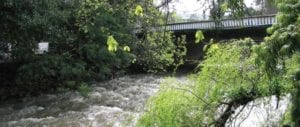The levels of human excrement and disease-causing pathogens in rivers around Stellenbosch are unacceptable and unsanitary. People who use the rivers for sport and recreation stand a chance of contracting diseases such as diarrhoea, food poisoning and various types of infections.
The water of the Eerste and Plankenbrug rivers regularly do not meet international or national standards for the safe irrigation of fresh produce. These are the findings of the first thorough baseline study in more than a decade to quantify the extremely poor microbial state of the two rivers. The study, published in the Water SA journal, was led Prof Trevor Britz of the Department of Food Sciences at Stellenbosch University. It focused on the impacts that the polluted rivers have on food safety and human health. Britz’s research team monitored the types of microbes and chemicals in the Plankenbrug and Eerste rivers over more than three years across different seasons. The rivers pass through Stellenbosch and are used both upstream and downstream of the town to irrigate grapes, pears, citrus fruit, lettuce, strawberries, peppers, herbs and green beans, among others, especially during the summer months. Samples were taken once a month on a Monday morning for 42 months, from September 2007 to March 2011. A high variety and extreme levels of waterborne faecal bacteria, protozoa and viruses were found in the water as well as on produce irrigated from the rivers. Various disease-causing pathogens are able to attach to plant tissue. These can be harmful to humans if the produce is eaten raw and untreated. According to the South African Department of Water Affairs (DWA) and the World Health Organisation (WHO), levels of less than 1 000 faecal coliforms (bacteria that are present in the intestines of humans and animals) per 100 ml sample of water is considered safe to use for irrigation. However, higher concentrations of faecal indicators in the Plankenbrug and Mosselbank were found in more than 70% of the samples, and to a lesser extent also in the Eerste and Berg Rivers. “The Stellenbosch rivers clearly do not meet the minimum guidelines of the WHO or DWA, and are therefore not safe to use at all – not for irrigation, consumption, recreation nor sports,” said Britz. “There is a high risk of exposure to human pathogens when water from these rivers is used to irrigate produce that is consumed raw or without any further processing steps. “Do not swim in them or drink untreated water, and if you are eating fruit or vegetables irrigated from these rivers make sure you wash it properly, preferably with a mild disinfectant like Miltons added to the water.” What was found?- The researchers reported acceptable levels for irrigation purposes of physicochemical properties such as temperature, acidity and alkalinity levels.
- However, microbial tests show that human excrement in particular is severely polluting the rivers.
- High concentrations of faecal indicators in the Plankenbrug and Mosselbank rivers were present in more than 70% of the samples, and to a lesser extent in the Eerste and Berg Rivers.
- Concentrations of more than 1 million microbes per 100 ml of water were often measured. According to the WHO and DWA guidelines, it points to severe unsanitary conditions.
- More than 30 types of bacteria and 180 phenotypic variations of the bacterium E.coli were found. E. coli generally found in human and animal guts and its presence in a sample means that human or animal faeces is present in the water.
- Other potential pathogens such as Staphylococcus (food poisoning), Klebsiella (respiratory infections), Listeria (listeria infections) and Salmonella (food poisoning, diarrhoea or kidney failure) were also found.
“The high counts of Salmonella on their own pose a serious risk of potential food poisoning, since some residences on the banks of the Plankenbrug and Eerste Rivers draw water for gardening or household purposes,” Britz said.
Pollution levels were found to be constantly high throughout the year, irrespective of season or water temperature. Extremely high levels were even noted after heavy winter rainfalls. “This is probably because of increased run-off from the informal settlements or churning up by stormwater of bacteria trapped in the river sediment,” he noted. Certain human-based pathogens were also measured in boreholes, which might indicate that underground water sources have now also become contaminated because of seepage from the rivers. “Based on the extremely high levels of contamination shown in the water and on irrigated produce, it is time to seriously put measures in place to prevent serious problems for our agricultural sector and the local population,” says Dr Gerhard Backeberg of the Water Research Commission (WRC).Part of nationwide study The Stellenbosch findings are part of a nationwide study, the results of which were released in July in a four-part report documenting the extent of pollution in many South African rivers that are used for irrigation purposes and the impact this has on food safety and human health. The national study was led by food scientist Britz and colleagues from Stellenbosch University, the University of Pretoria, the University of KwaZulu-Natal and the University of Venda. Funded by the South African WRC and the Department of Agriculture, Forestry and Fisheries, the extensive research project of almost R5 million was launched in 2007 amid growing concerns that South Africa’s river water no longer meets exports standards for fresh produce set by the European Union, nor the health standards of local authorities or the WHO. The national study included rivers such as the Eerste, Plankenbrug, Mosselbank and the Berg rivers in the Western Cape, the Baynespruit River in KwaZulu-Natal, the Mutshedzi River in Limpopo, the irrigation canal from Loskop Dam and the Olifants and Wilge rivers in Mpumalanga, as well as the Skeerpoort, Moses and Klip rivers in North West. These rivers are regularly used to irrigate agricultural produce. The overall findings of the national study were:
- The microbial results showed high concentrations of faecal microorganisms with concentrations reaching 10 million cells and indicate unsanitary conditions. This is ten thousand times higher than the allowed, safe levels set by the WHO and DWA.
- In particular, the E. coli concentrations in most cases exceeded the maximum acceptable guidelines of the WHO and DWA.
- Other potential pathogens including Staphylococcus, Klebsiella, Listeria and Salmonella, intestinal Enterococcus, faecal coliforms, commensal and diarrhoeagenic E. coli, diarrhoea-causing viruses (NoV GI and GII, and HAV), Cryptosporidium oocysts and Giardia cysts were also measured in many of the rivers. One or more such enteric virus was found in 18% of river water samples and 9% of irrigation canal samples.








